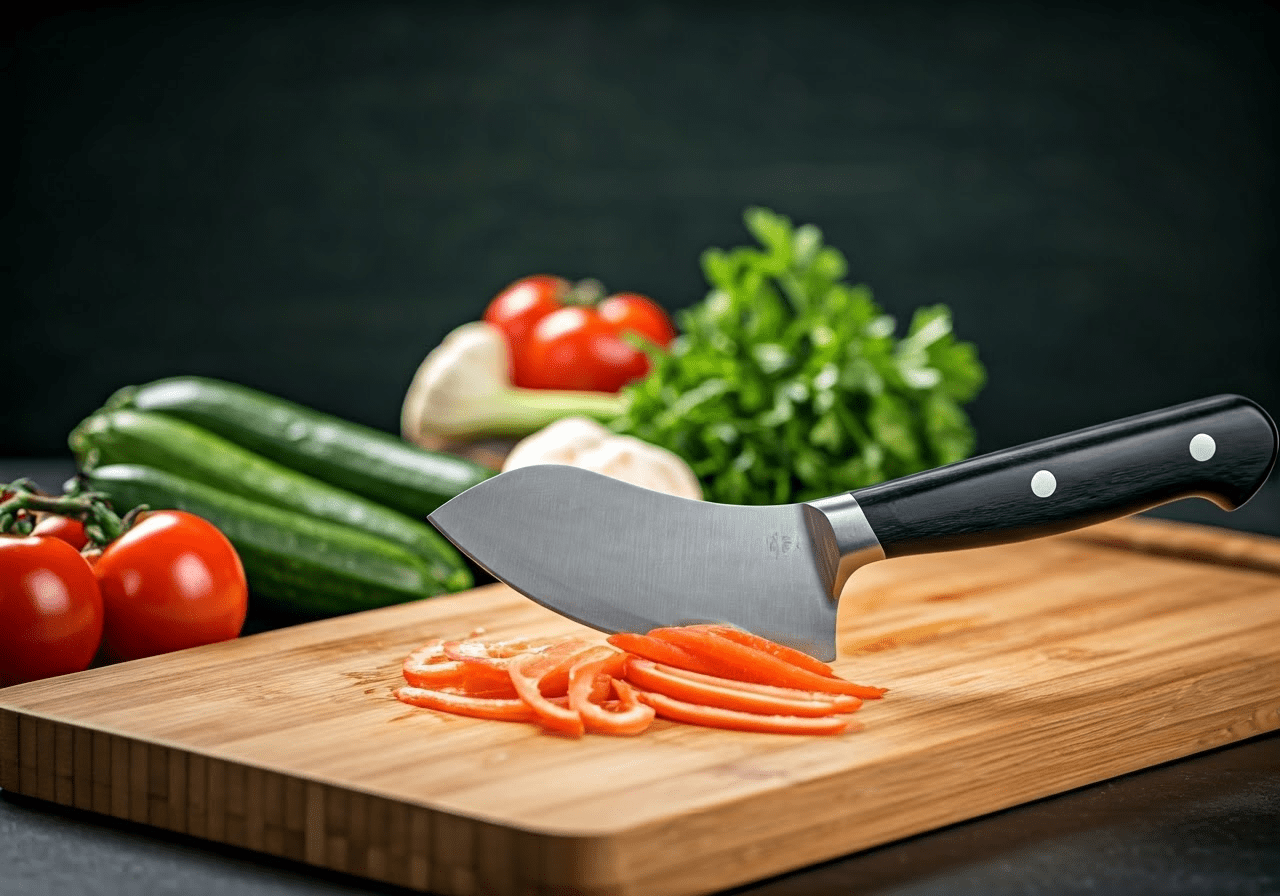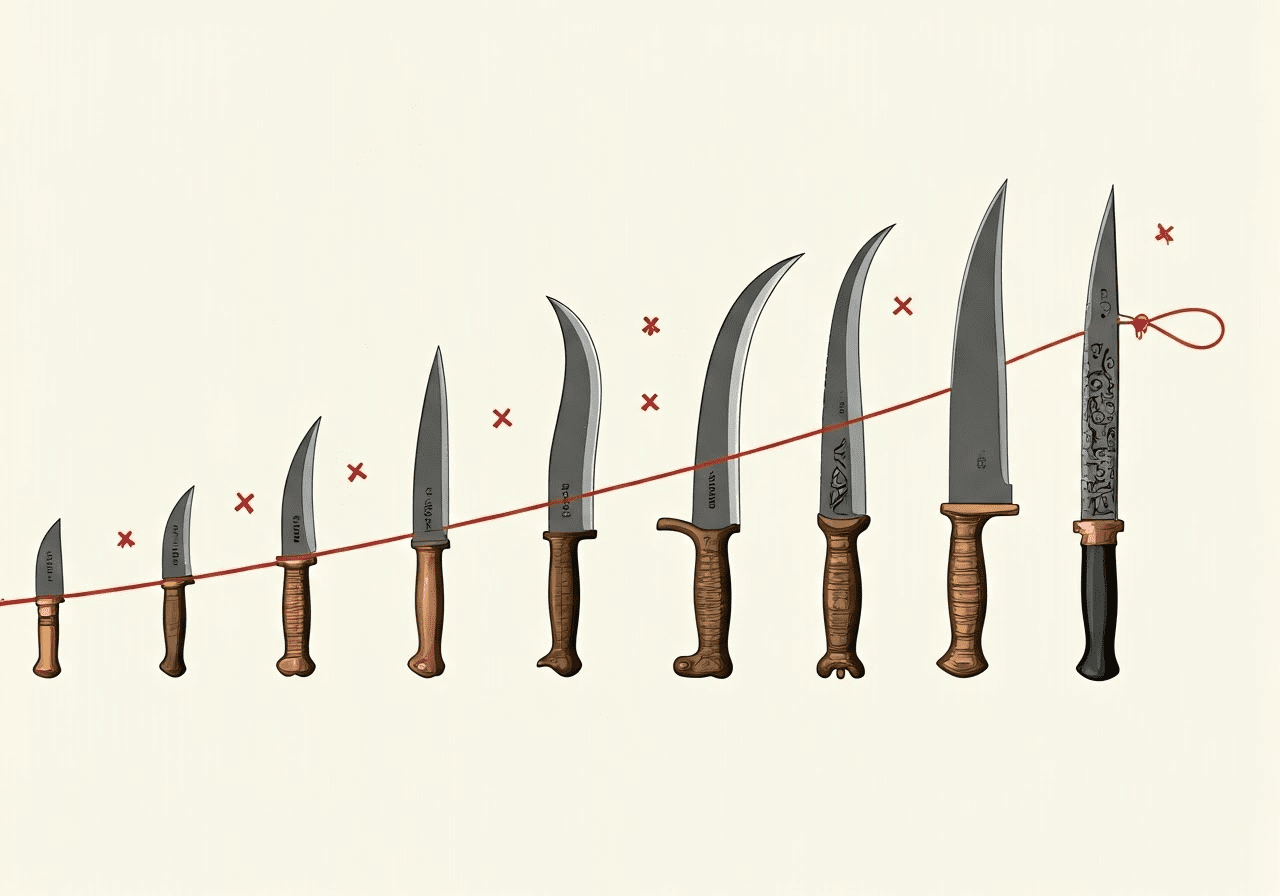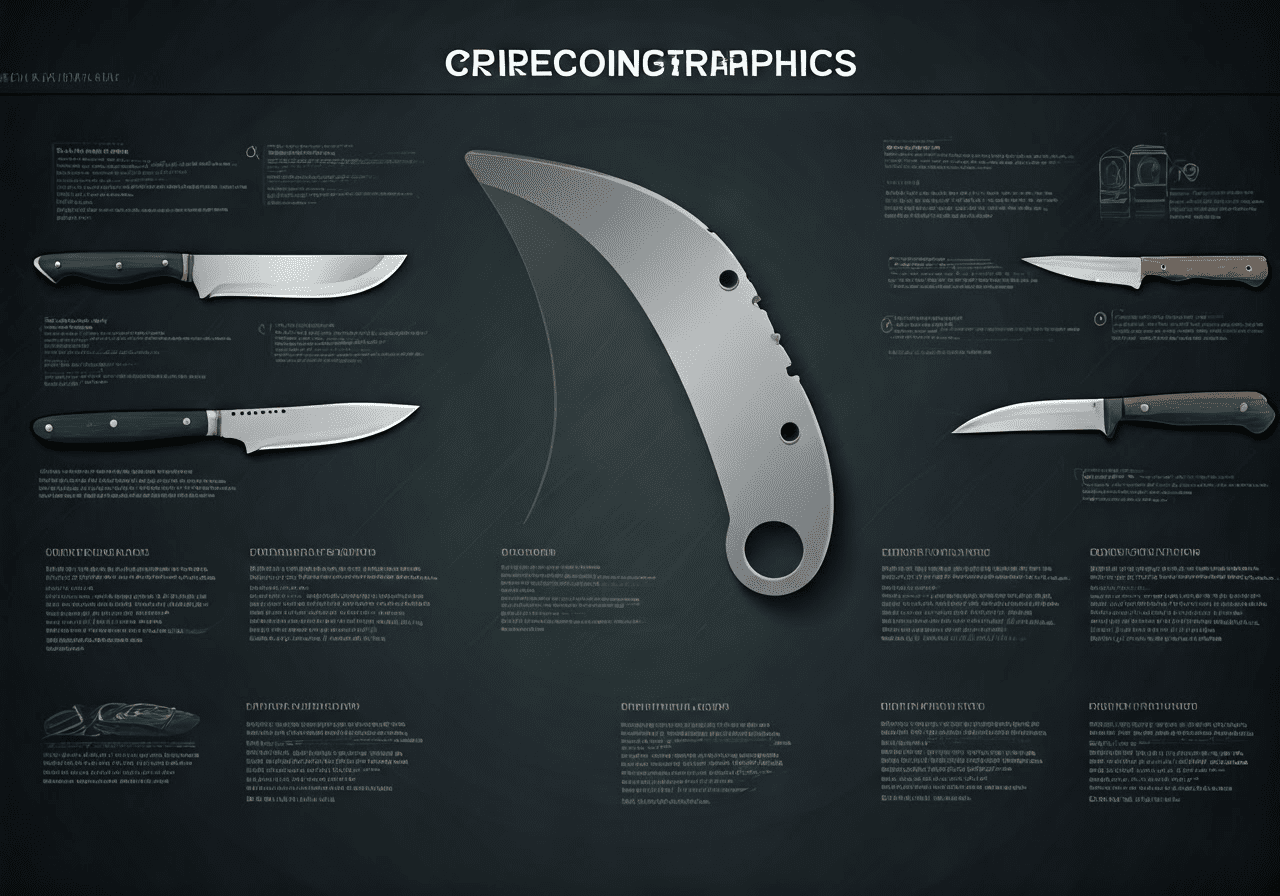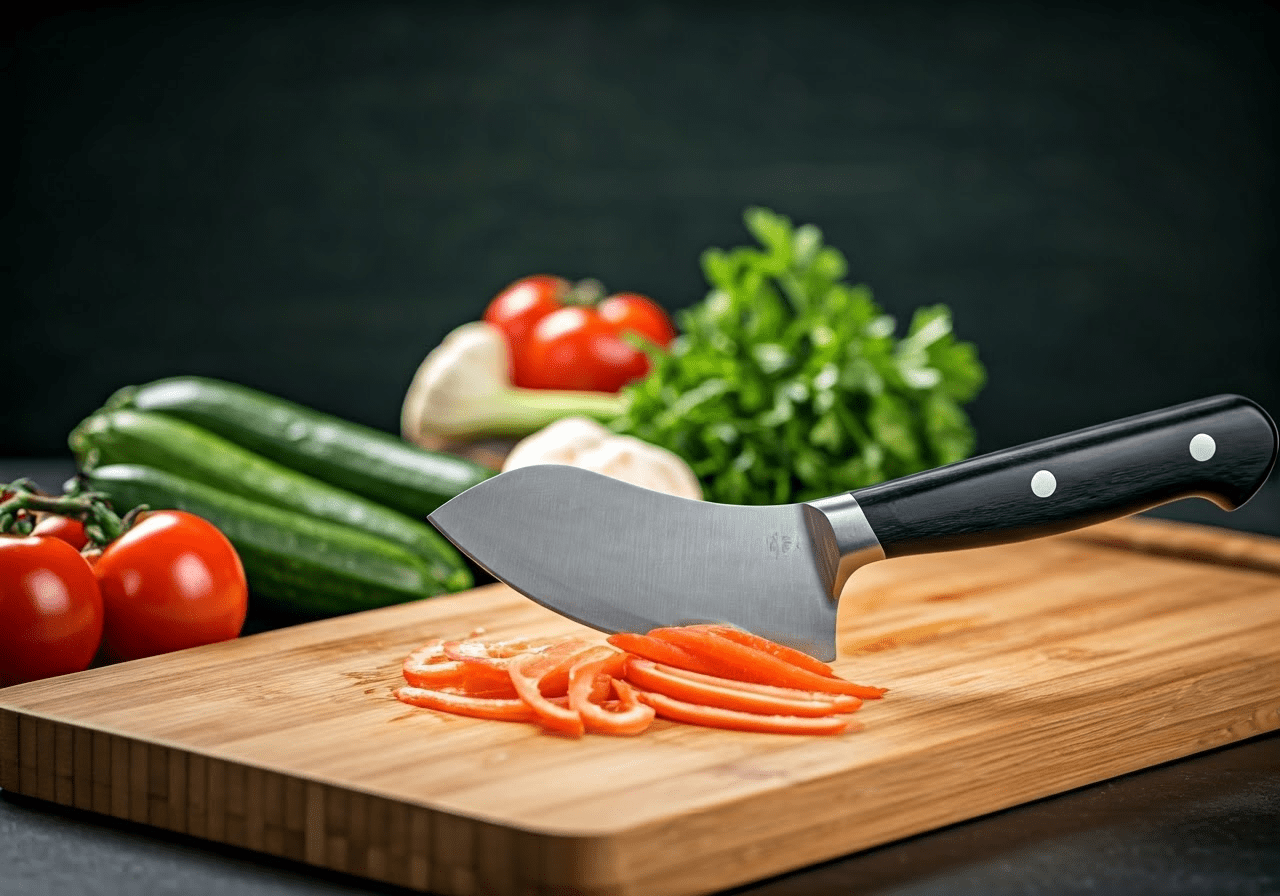
Table of Contents
Key Highlights
- The curved blade of a knife isn’t just for aesthetics; it serves a practical purpose, enhancing its functionality in various cutting tasks.
- The curve allows for a rocking motion, making chopping, mincing, and slicing more efficient and precise.
- Different types of knives have varying degrees of curvature, tailored to their specific culinary uses.
- The history of knife design reveals a fascinating evolution from straight to curved blades, influenced by cultural practices and culinary needs.
- Understanding the anatomy of a knife, particularly the role of the blade curve and the pointed tip, unveils the secrets behind its remarkable efficiency.
Introduction
Have you ever stopped while using your kitchen knife and looked at the curve of its blade? This curve is not just pretty; it is very useful too. The curved blade shows how cooking tools have changed over many years. It helps a kitchen knife cut better and work faster for different jobs. Let’s explore the reasons why blades are curved at the end.
The History of Knife Design

The story of knife design is an interesting one that shows how our needs changed and how technology improved over time. In the beginning, people made knives from flint and obsidian. These early knives were mainly tools for hunting and staying alive. They had simple, straight shapes that worked well for their jobs.
As societies grew and cooking skills improved, knife design changed too. The development of metalworking gave us stronger and longer-lasting blades. This opened up new ways to change shapes and designs. During this time, knives began to shift from straight blades to the curved ones that we enjoy using now. This change happened because people wanted knives that worked better in the kitchen.
Evolution from Straight to Curved Blades
The change from straight blades to curved blades didn’t happen all at once. It was a slow evolution shaped by many factors. As different cultures created their own cooking styles, they also made new tools. The different shapes of knives we see today show this mix of cultural creativity.
Functionality played a big role in this change. Curved blades are better for tasks that need a rocking motion, like chopping herbs or mincing vegetables. This rocking action helps use force more efficiently and results in cleaner and finer cuts.
Also, the curve of the blade added versatility to knives. By changing the shape and the degree of the curve, knife makers could make special tools for certain jobs. This could be slicing meat, filleting fish, or chopping vegetables with precision.
Cultural Influences on Knife Shapes
One clear example of how culture affects knife design is the Japanese Santoku knife. This useful knife is important in Japanese cooking. It has a unique curved blade that shows Japan’s cooking traditions. The name Santoku means “three virtues” in Japanese. It is great for slicing, dicing, and mincing, representing the heart of Japanese cooking skills.
The curve of the Santoku’s blade, which usually has a straighter edge near the heel, is meant for a push-cut technique. This method is often used on Japanese cutting boards. It is different from the rocking motion that Western-style knives use. This shows how knife design connects with cooking methods.
From the smooth shape of the Santoku to the strong curves of a chef’s knife, you can see each culture’s influence in their cooking tools. These design differences are not just for looks. They show the different ways people prepare food around the world.
Understanding the Anatomy of a Knife
To really understand how smart a curved blade is, we need to know the basics of a knife. A knife has two main parts: the blade and the handle. The blade is usually made of steel. It does the work of cutting, slicing, and dicing.
The handle is often made from wood, plastic, or other materials. It helps you grip the knife and control it well, so you can use the blade effectively. The connection between the blade and the handle matters a lot for how well the knife works and for safety. This shows us why good design is so important, especially for a curved blade.
The Role of the Blade Curve
The shape of the blade is very important for how well the knife works. When you use a curved blade knife, you can use a rocking motion. This creates a shearing effect, which means the force is spread out better on the cutting surface.
The curved edge helps reduce friction. This lets the blade slide through food easily. For example, when you try to slice a ripe tomato with a straight knife, it might crush the soft flesh. But with a curved chef’s knife, it cuts smoothly and keeps the tomato whole. This idea works for many cutting tasks, like dicing onions or slicing meat.
Also, the curve of the blade helps when you want to scoop and shift chopped ingredients. The curve acts like a small shovel, making it easier to move diced herbs from the cutting board to a pot or bowl. This small detail greatly helps with food preparation.
Significance of the Knife’s Point
The knife’s pointed tip is just as important as the curved blade. This tip adds flexibility and accuracy to how the knife works. It helps the user do fine jobs like deveining shrimp, taking seeds out of chili peppers, or making fancy decorations for dishes.
The pointed tip is also very useful when working with small items. It helps give more control and precision. For instance, mincing garlic needs a sharp tip to cut it into small, even pieces. This tip is also key when scoring bread dough. It helps the dough rise well while baking.
Together, the curved blade and the pointed tip work well to make the knife more helpful and adaptable in the kitchen. From slicing and dicing to special tasks, these features make the knife a must-have for cooking.
Types of Knives and Their Curves

The world of knives is much bigger than just the chef’s knife. There are many shapes and sizes, and each is made for special cooking tasks. The blade’s curve is one key feature that changes a lot between different knives. This shows what they are meant to do.
For example, a boning knife has a gentle curve. This helps it move carefully around bones. On the other hand, a scimitar has a strong curve that is great for slicing. Each knife’s curve shows how it works best in the kitchen.
Chef’s Knives: A Closer Look at the Curve
The chef’s knife is a key tool in any kitchen. It shows how important good design is in making cooking easier. Its wide blade has a slight curve that helps with many tasks.
This curve lets you rock the knife back and forth. This makes chopping, mincing, and slicing much faster and simpler. Whether you are cutting lots of veggies for a stir-fry or mincing herbs for a sauce, this knife can do it all.
Here are some important features of the chef’s knife:
- Wide blade: It has a big surface area for chopping and moving ingredients.
- Slight curve: This curve helps with an easy rocking motion for cutting.
- Versatile: It works well for many kitchen tasks, from chopping veggies to slicing meat.
With its curved blade, the chef’s knife really shows how thoughtful design can make cooking more enjoyable.
Slicing and Carving Knives: Purpose of the Curvature
Slicing and carving knives are different from strong chef’s knives. They usually have a noticeable curve and a thinner blade. This helps to cut thin and even slices of meat, poultry, or fish. The thin blade and the curve reduce drag, allowing the knife to move easily through the food.
When you carve a roast, the curved blade of a carving knife allows for smooth and gentle cuts, creating neat and even slices. This is great when putting food on display. It makes a simple meal look like a special feast.
A soft cheese knife also has a thin and curved blade. It easily cuts through soft cheeses. This creates nice-looking slices without crushing or changing their soft texture. Whether cutting a savory roast or a creamy brie, the special curve of these knives makes sure that slicing is precise and looks good.
What is the bent knife for?
The term “bent knife” may sound strange, but it refers to a key feature found in many knives: the curved blade. This curve is not just for looks; it is a smart design choice that improves the knife’s functionality and versatility.
The curved knife is great for different tasks. You can use it for dicing vegetables accurately or slicing meat easily. The curve helps make smooth cuts, reducing friction and protecting delicate ingredients. Whether you are a skilled chef or a home cook, a curved knife is very useful in many cooking tasks.
Practical Benefits of Curved Knives
Curved knives are not just nice to look at. They help make cutting tasks easier and more precise. The curved blade has been developed over many years and is a must-have in kitchens all over the world.
Using a curved knife lets you chop herbs easily with a rocking motion. It also helps you slice meat smoothly. This makes cooking feel more enjoyable instead of just a chore.
Enhancing Precision in Cutting Techniques
One of the biggest benefits of a curved blade is that it helps with precision in different cutting methods. For example, when mincing garlic, a chef’s knife with a curved blade can rock back and forth. This keeps the tip on the cutting board, which helps make sure each piece is the same size. It is hard to do this with a straight-edged knife, as it often lifts off the board.
Also, when dicing onions, the curved blade moves through the layers smoothly. This makes nice, even cuts without squashing the soft cells, which keeps the flavor and texture good. It’s important to keep even pressure while cutting to get a professional look.
The curved blade also helps with precision when slicing gentle ingredients like tomatoes. The curve lets the knife slide through easily, reducing bruising and keeping the juice of the fruit intact.
Facilitating Easier Chopping and Mincing
The curved edge of a knife helps with more than just being precise. It makes chopping and mincing easier and less tiring. The way the knife rocks back and forth spreads the force along the blade, so you don’t have to work as hard for nice, clean cuts.
Think about chopping fresh parsley with a straight knife. You would need to press down hard, which could crush the soft leaves and ruin the flavor. On the other hand, a chef’s knife with a curved blade lets you easily rock through the parsley, keeping its beautiful green color and fresh smell.
This is also true when you mince garlic, ginger, or other ingredients that need to be chopped fine. The curved blade moves smoothly, creating a nice rhythm in the kitchen as you easily prepare your meals.
Why are carving knives rounded?
The rounded tip on a carving knife is interesting and has an important purpose. This design helps the knife work better. It allows the knife to move smoothly over bones without catching or ripping the meat.
When you carve a roast, the rounded tip makes it easier to go around the bones. This results in slices that look nice and are neat. This feature is really helpful when serving bigger cuts of meat. It makes sure each slice looks good and is cut with precision. The rounded tip may be small, but it shows how carefully these special cooking tools are designed.
What is the curved knife called?
The term “curved knife” includes many types of knives. Each type has its own name and purpose. There isn’t one clear answer about what defines it, as it depends on the knife’s shape and use. Here are some popular examples.
The Japanese Santoku has a curved blade that shows the elegance and skill of Japanese cooking. The cleaver is another kitchen tool that is known for being heavy and powerful. It also has a curved blade, but its shape is made for chopping bone. From the gentle curves of a filleting knife to the strong curve of a butcher’s knife, every curved blade shows a story of special kitchen art.
Why do knives have a jagged edge?
Not all knives have a smooth edge. Some, like the bread knife, have a serrated edge. This edge has sharp teeth that cut through tough surfaces while keeping the inside intact. This special design solves a problem: it helps to lower friction and stops crushing.
Think about cutting a hard loaf of bread with a smooth knife. The blade would squash the bread, making a messy and uneven cut. On the other hand, the serrated edge of a bread knife works by using a sawing motion. It easily moves through the crust, and the teeth make clean cuts, leaving perfect slices. This same idea works for other foods with hard skins, like tomatoes and citrus fruits.
Why are knives shaped the way they are?
The shape of a knife is important. The curve of the blade and the design of the handle show years of improvement. This has been done to make knives more efficient, precise, and comfortable for users. Knife design is not just about looks. It is about making sure the knife works well and feels good to use.
The knife’s shape affects how it can cut. For example, a chef’s knife is good for a rocking motion, while a paring knife is better for careful slicing. Things like blade length, width, and curve, along with the handle design, change how a knife feels in the hand. This affects control and how tired your hand might get. A good knife should feel like part of your hand, helping you cut with precision and reducing stress during long use.
What is the purpose of a crooked knife?
The term “crooked knife” means a special tool with a curved blade. It is mainly used in woodworking, especially by indigenous people. They use it to carve detailed shapes and patterns. The blade is often sharpened on the inside, which lets the person work with precision on both curved and flat surfaces.
The crooked knife is different from regular cooking knives. Its curve looks like a crescent moon. This design helps the user pull the knife toward themselves, giving more control when working with wood. It is great for carving spoons, bowls, and even creating detailed totem poles. The crooked knife shows the skill and creativity of traditional woodworking methods.
What is the superstition about closing knives?
Superstitions about knives are common in many cultures. These beliefs mix practical advice with old traditions. One popular superstition says that leaving a knife open brings bad luck or can even be dangerous. The reason for this belief is not clear, but it likely comes from a time when knives were valuable and could be used as weapons.
Closing a knife before putting it down was not just polite. It was also for safety. An open knife could hurt someone, especially kids or pets. As time went on, this useful tip mixed with superstition. A simple safety rule turned into a belief many people now follow.
Why are knives scalloped?
Scalloped knives have rounded cuts along their blades. This design helps reduce friction and makes slicing easier. These cuts, called grantons, create air pockets. This means there is less contact between the blade and the food. As a result, the knife does not stick as much.
Think about slicing a ripe tomato with a normal knife. The flat surface may create suction, making clean slices hard to get. But a scalloped knife moves easily through the tomato’s soft flesh. The air pockets stop sticking and allow for a smooth cut. This design is especially useful for moist foods or those that stick easily. It helps keep their look and texture nice.
What are curved knives good for?
Curved knives are flexible and easy to use in many cooking tasks. You can slice, dice, and even perform special techniques with them. The curved blade moves back and forth, making it quick to chop herbs, mince garlic, and dice onions evenly.
These knives are also great for slicing meat, chicken, and fish. The curved edge cuts through smoothly, making clean and precise slices. Whether you are a pro chef or just cooking at home, curved knives are must-have tools. They make cooking easier and help you create tasty and attractive meals.
What is the purpose of a curved dagger?
Curved daggers have a unique blade shape and a long history. They are often linked to war and self-defense. The curved blade is better than straight blades found in swords for slashing and hooking. This makes them great for close combat.
With their shape, these daggers cut more effectively. This means the user can cause more harm with each move. The design helps target weak spots on an opponent, making curved daggers powerful weapons when used by skilled individuals. Beyond their use in battles, curved daggers also have cultural value in many places. They symbolize strength, power, and fighting skills.
What does a curved knife do?
A curved knife changes how we handle food. It makes cutting easier and more accurate. The magic of the curved blade is its ability to rock or slice with less effort. This gives us more control while cutting.
Think about chopping herbs. If you use a straight knife, you have to chop hard. This can damage soft leaves and make everything look uneven. A curved knife, however, moves smoothly. Its shape helps create a gentle rocking motion. This keeps the leaves fresh and tasty. Whether you are dicing onions or slicing meat, a curved knife makes cooking more fun and enjoyable.
Why are knife blades curved?
The curved blade is an important feature in many knife designs. It shows how good design works together with function in kitchen tools. This simple curve is not just for looks. It helps with how comfortably the knife is held, makes cutting easier, and opens up more options for cooking.
The curved blade is great for a rocking motion. This technique is used for chopping, mincing, and slicing. The shape of the blade helps spread out force. This reduces strain on the wrist. You can use it for longer periods without getting tired. Whether you are a professional chef or cooking at home, the curved blade makes cooking more comfortable. It gives you better control and a more pleasing cooking experience.
Conclusion
In conclusion, the curve of knives is useful for many reasons. It helps with cutting precision and makes chopping and mincing easier. When you learn about the different parts of a knife, like the blade curve and point, you see how knife design has changed over time and how culture has influenced their shapes. There are different types of knives. Each one has its own curve that fits certain cooking tasks, like chef’s knives and slicing knives. The curved blade design makes cutting easier and faster in daily cooking. Embrace the versatility and functionality of curved knives to improve your cooking skills.
Frequently Asked Questions
Why are some knives more curved than others?
The shape of a knife’s blade is important for its use. Knives meant for slicing, such as carving knives, have a greater curve. This helps to make longer, smoother cuts. On the other hand, knives used for dicing and mincing, like a chef’s knife or Santoku, have a less curved blade. This design allows for better control when rocking the knife back and forth.
Can a straight knife perform the same tasks as a curved knife?
You can use a straight-edged knife for tasks meant for a curved knife. However, you will lose some efficiency and precision. The curved blade’s rocking motion is great for chopping and mincing on a cutting board. It’s hard to copy that motion with a straight edge.
How do I choose the right knife curve for my cooking needs?
Think about the tasks you do most in the kitchen. A chef’s knife or Santoku works great for many tasks because it has a curved blade. If you need to slice roast or poultry, a carving knife with a strong curve is best. A cleaver, with its weight and curve, is good for cutting through bones.


